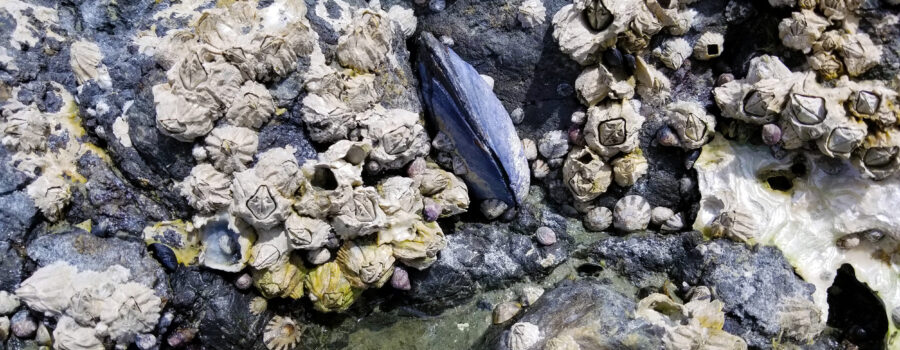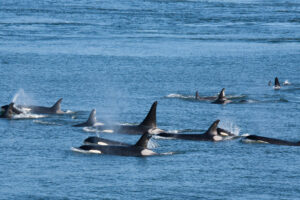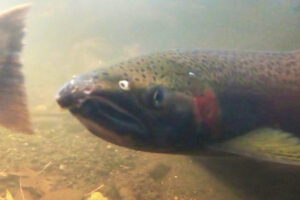On a cold, dark, and mercifully dry night in October 2019, I ventured out with a team of two other Puget Soundkeeper volunteers to Fourmile Rock in Elliott Bay at low tide to deploy mussels. I’m pretty sure they were Penn Cove mussels to be specific. Live ones. We had about 50 of them on ice in the back of my car. Our job was to secure them in a cage so they could do what they do best for the next three months – filter water.
Why mussels?
I can hear you asking “Why?” One mussel can filter approximately 25 liters of water per day.1 This is how they capture food in the water. They capture a lot of things that are not food too, notably microplastics and chemical compounds that we consider to be toxins. They don’t have livers to detoxify their systems, so they cannot readily purge those compounds. These substances get stored in their tissues.
If you place mussels that you know are relatively uncontaminated in the water, and you let them do their thing for a few months, you can collect them and measure the chemicals they filtered from the water during that time. If you do this over many years, you can track changes in the level of toxins in the water. The Washington Department of Fish and Wildlife (WDFW) uses this strategy for several water-quality monitoring programs.
Deployment
Back to the dark beach… The low tide on October 28, 2019, occurred after 11:00 pm. It was inky dark and slippery down on the rocky beach at Four Mile Rock (GPS coordinates approximately 47.63, -122.41). The water was black but reflected lights from the Port of Seattle across the bay. Nice view. The three of us were armed with a roughly 18-inch cubic cage, steel bar anchors, a mallet, a fistful of cable ties, and of course, the mussels. We selected a spot at the water’s edge so that at high tide it would be deep underwater and worked quickly to secure the cage before the tide started to come back in.
We drove steel anchors down two feet into the rocky beach. That is a lot easier once you figure out that twisting them like a drill bit is the way to go.

Securing a steel anchor 
Securing the mussels 
Securing the lid
The mussels were already packaged in nets so that we could quickly hang them in the cage enabling water to flow freely around them. Then we secured the lid with cable ties. Securing the lid is more important than you might think. No, the mussels can’t escape, but you need to keep the sea stars out! They are strong burglars. If there is even the smallest gap at the edge of the lid, a sea star can pry it open, crawl inside. Jackpot! Mussels gone. Monitoring experiment over.
Recovery
We returned late on the evening of January 21, 2020, to collect the mussels. Of course, this time it was colder and raining sideways. Classic. We were happy to see that the cage was still secure and the mussels were still intact!

We realized quite quickly that scissors are almost useless against cable ties. You need wire cutters. After wrestling with the ties for a while we finally opened the lid, recovered the mussels, collected all the cable tie pieces, and exited the beach up a slippery, steep hill with all of our gear.
Results
After all of that effort, it would be great to know the results quickly, but alas, science can’t be rushed. It takes a long time for the WDFW to analyze the mussels collected from dozens of locations around Puget Sound. We probably won’t see the 2019/2020 report until 2021, but the 2015/2016 report provides a preview of what we can expect:
“We recovered mussels from 90% of the sites and survival was over 78%. The most abundant organic contaminants measured were PAHs, PCBs, PBDEs, and DDTs. PAHs and PCBs were detected in mussels from every site, and the concentrations were significantly higher in Puget Sound’s most urbanized areas…These findings suggest toxic contaminants are entering the nearshore food web of the greater Puget Sound, especially along shorelines adjacent to highly urbanized areas.”2
These contaminants largely come with the stormwater runoff that flushes our streets into the Sound where it is clearly entering the food web.
What can we do?
I’ll leave a discussion of stormwater management for another article, but for now, if you want to know what you can do to help clean up our stormwater, check out your city’s or county’s website. It should have information on how your community is approaching the problem. For example, here is the King County Stormwater Services Information site.
Go Deeper!
Go Deeper to explore the ocean and the Salish Sea through a curated list of articles, books, films, and other resources.
To learn more about the topic in this article, check out the following resources:
- Washington Department of Fish and Wildlife. Stormwater Action Monitoring 2015/16 Mussel Monitoring Survey
- Puget Soundkeeper. Mussel Monitoring!
End Notes
1Bottollier-Depois, Amélie. “Mussels, ‘Super-Filters’ That Can Help Beat Water Pollution.” Phys.org, Phys.org, 18 Aug. 2019, phys.org/news/2019-08-mussels-super-filters-pollution.html.
2 Lanksbury, Jennifer, et al. Washington Department of Fish and Wildlife, 2017, Stormwater Action Monitoring 2015/16 Mussel Monitoring Survey, wdfw.wa.gov/sites/default/files/publications/01925/wdfw01925.pdf?eType=EmailBlastContent&eId=392a1914-765b-47d8-9f14-e8f708d84936.
1






Leave a Reply
Your comments are welcome.